Frustrated gamers are just trying to make up for lost time. Thanks to FLEX-arcade, I have traveled the first part of the path to Accomplishment: a terminal sits in my living room. All that remains is for me to embark on the second objective: to dive into the 8,000 video games (and in particular arcade games) now at my disposal. And why not start by bike and distribute newspapers in the neighborhood? Insert a Corner, let's go for Paperboy !
SUMMARY
- Where do we put the wheels? Little story of Paperboy
- Paperboy, a stupid arcade game
- Paperboy, an evil video game
- A rich game!
- Additional resources at Paperboy (soundtrack, advertising, etc.)
Obviously, I could have launched my epic into retrogaming with the list kindly provided by this blog of 10 Best Games in History. But let's be frank: I'm a gamer as passionate as I am, and monuments intimidate me. Paperboy offers in contrast a reassuring and familiar program.
Familiar, yes, because I seemed to have seen him somewhere before, this kid on a bike. On a machine called Amstrad CPC (6128? 6128), like the one at home, except that it was not at my house. Regrets. Furthermore, the theme and setting of the game smell of American cinema for teenagers from the 1980s, that ofAND, of the Goonies… Newspapers on the landing, bicycles, sprawling suburban suburbs, a repetitive world but full of details and micro-variations. My bike ride in Paperboy will not end in the air like that ofAND, but I bet you Ma-borne-à-moi that it will be eventful.
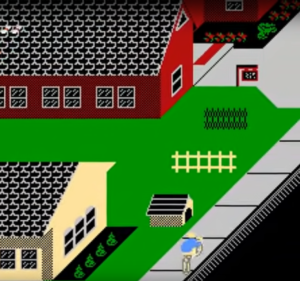
1. Where do we put the wheels?
A story of Paperboy
Atari, NES and handlebar terminal
In fact, a search on the Internet tells me that Paperboy can also be considered a video game monument. I feel dizzy... It was published by Atari in 1984 for a super cool dedicated arcade machine WITH integrated handlebars. So what do I do? I am complaining to my manufacturer about the absence of this historic handlebar on Ma-borne-à moi? Well, at the same time, 8000 games…
The game was a great success and was of course developed very quickly for consoles and PC, on almost all platforms: Atari, Amiga, Amstrad CPC, Commodore, Game Boy, Game Gear, Megadrive, Lynx, NES… The version featured on my FLEX-Arcade terminal is precisely that of the NES, for Nintendo Entertainment System (1983-1995), which in France we just called “la Nintendo” at the time, or “ma Nintendo”, if we had one, or “ta Nintendo” if we had the chance to be familiar with the one who had “his Nintendo”. Launched in 1988 on NES, Paperboy is also presented as one of the first games from an American studio published on Nintendo. The menu of Ma-borne-à-moi also teaches me that we can play Paperboy 2, news that we receive with the enthusiasm required. For the record, the NES looked like this:

Game of the Year 1986, ladies and gentlemen!
In 1986, Paperboy not only won the title Game of the Year from the British Software Industry, it also obtained a rating of 9.25/10 from the German magazine Aktueller Software Market (RIP 1995). In 1989 he received a rating of 100/100 from the British magazine ACE (RIP 1992). To be honest, the ratings drop from 1991 onwards, but in the end, the NES version of the game, the one that interests us, benefits from a rating of 8/10 from the site Honestgamers.com, which, as its name suggests, claims total independence in judging video games.
The references are good… Ah, I forgot, the Japanese title is ペーパーボーイ.
2. Paperboy, an arcade game
stupid as cabbage
The principle of the game can be understood in two seconds, which temporarily generates an illusory optimism. It includes 7 levels, each of which represents a day. The goal: deliver (actually throw) newspapers to the houses on a straight street presented to you at the start of each level, like this:

The white houses are those for subscribers to deliver: it involves throwing the newspapers onto the landing (this earns points) or, better, into the mailbox (this earns more points). The red houses are those of non-subscribers, not to be delivered. We can still throw newspapers at them which impeccably break their window. Free and delectable act? Yes, but not only that, as we will see later.
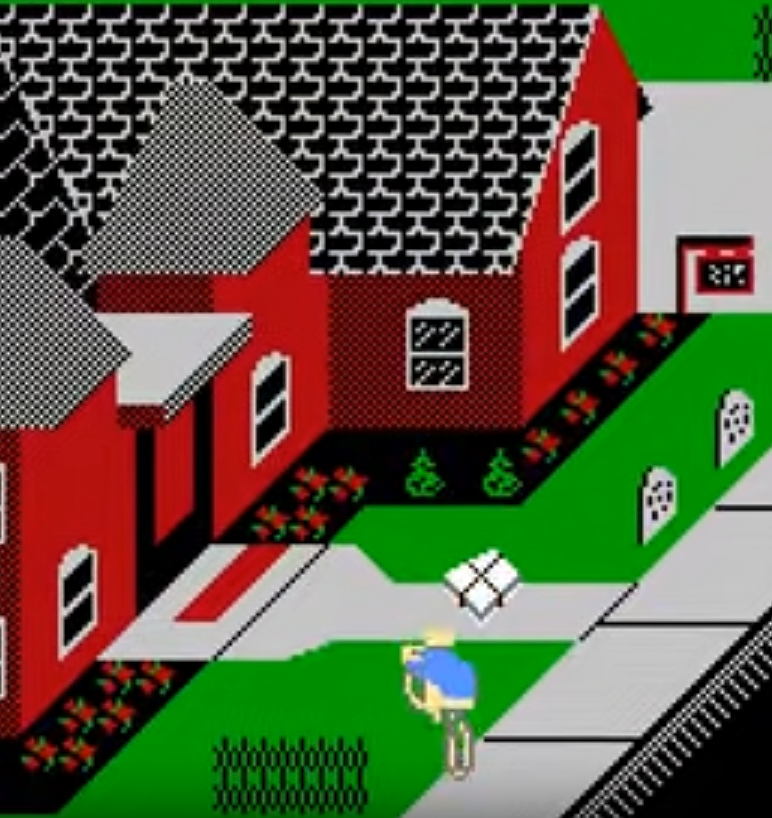
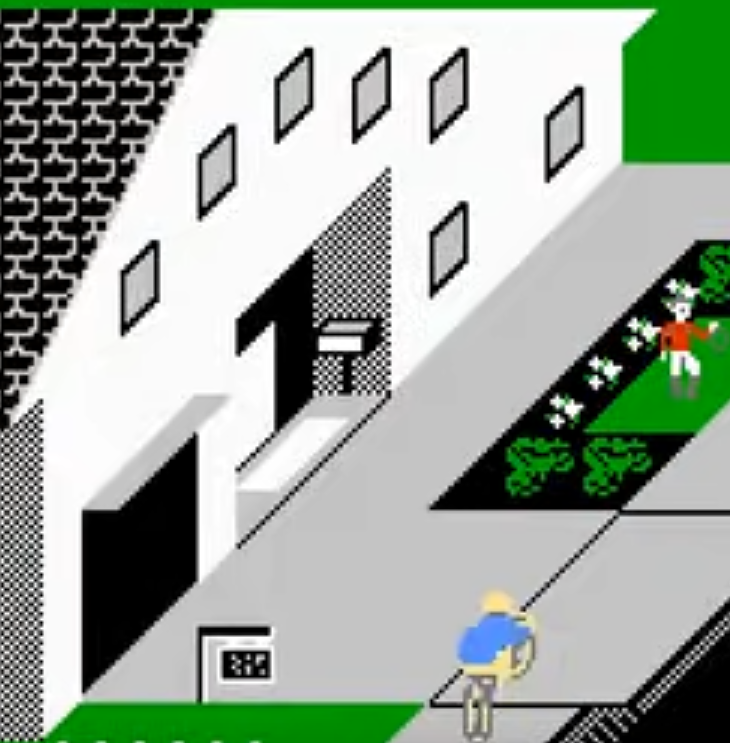
Your infernal machine moves forward on its own, we can (theoretically) brake but not stop. You “just” have to navigate from right to left and left to right to avoid obstacles. The obstacles are obviously numerous, incredibly numerous.
If you arrive at the end of the street, which for my part took me a good morning, you end the day with an improbable Training Course, or “course of various obstacles in a wasteland”. You have to avoid walls and moving grids by using ramps while throwing the last copies of newspapers into round targets, because this earns points.
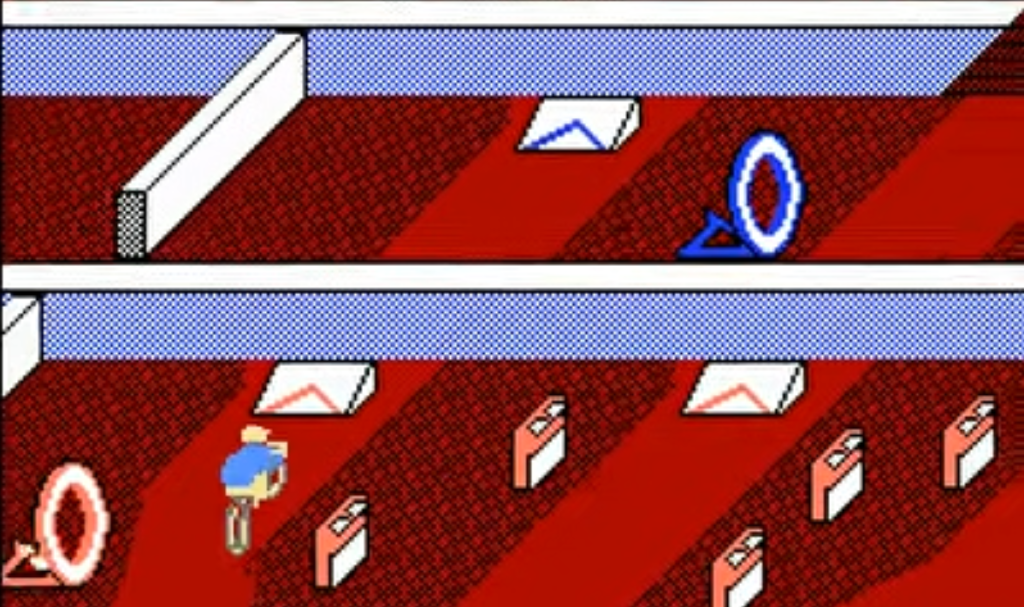
If you survive this and reach the word “Finish”, a meager crowd (three characters) cheers you in a stand designed for 200 spectators, judge for yourself.
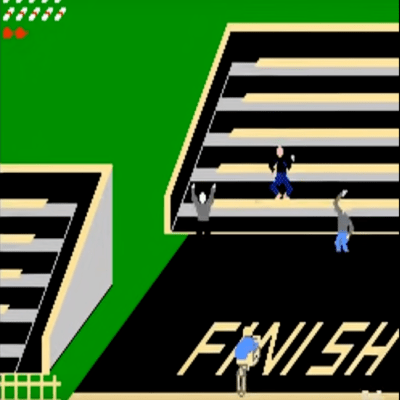
Poorly paid for a journey that was ultimately truly hellish, which had to start again the next day. And I'm only at Monday.
3. Paperboy, an evil video game
The endless learning of log throwing
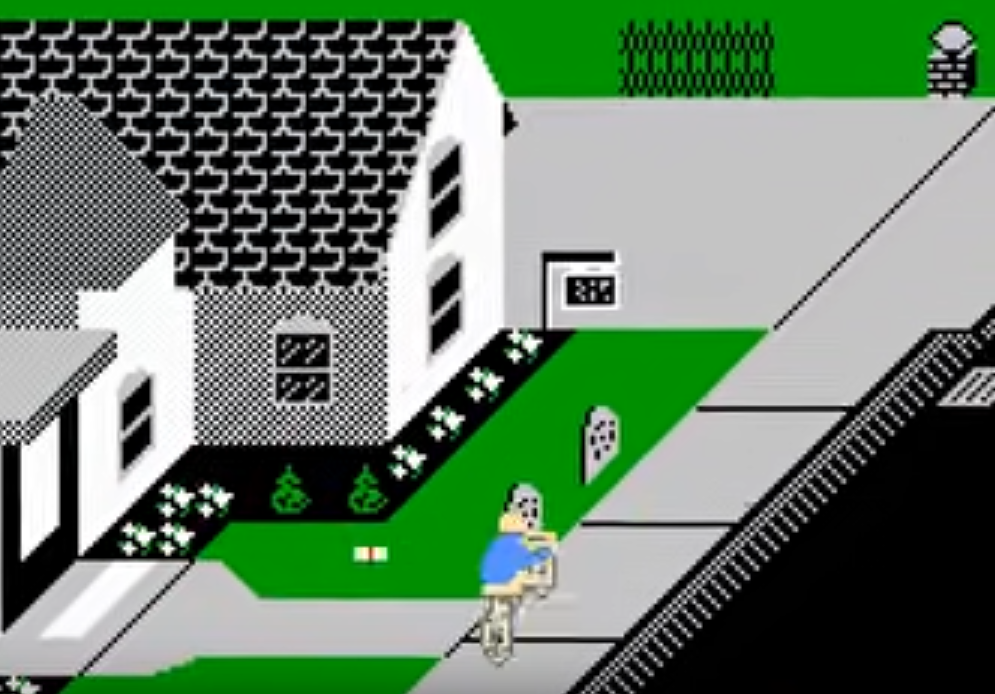
If you don't deliver the newspapers to subscribers' homes, they unsubscribe for the next day. Even worse, if you don't launch correctly the newspapers on the landing or in the mailbox, you smash a window, and you lose them (the subscribers, because the newspapers, anyway…).
You also only have a very small supply of newspapers: you have to collect piles of them on the way. If you don't collect them, because you had to avoid an obstacle at the same time, for example, or you are simply incompetent, you no longer have any. And if you run out of them, subscribers don't receive the newspapers. And you lose them.
A trick can save you, and I point it out because I didn't understand it until very late (I'm rubbish, have I told you enough?): by throwing newspapers into the windows of red houses, the inhabitants resubscribe for the next round (if you make it that far). Why are they doing this when their homes are being degraded? Mystery.

actually it's good.
Still, fortunately this trick exists, because it is much easier to launch the logs in the windows than on the target. Pressing the button at the right time to send the newspaper to the landing is difficult, but deliberately sending it to the mailbox is impossible… for me. I could perhaps consider it if the road was clear, but it is not at all.
Avoiding obstacles, a major art
How to coordinate your throw while preparing to avoid the solitary wheel that crosses the screen from left to right? And how can you avoid the wheel without leaving the sidewalk and hitting the car parked there? And damn, how do you get back on the sidewalk when there's a manhole looming and there aren't many good places to get back on the sidewalk? The trajectories to take in this game are strange. You will tell me, the physics of arcade games is strange, that is their interest. And you are right.
Finally, when it comes to the strangeness of the trajectories and angles, what's the point of talking about the final obstacle course? We think about taking the ramps without incident, and bam the wall.
There you go, that's the life of an ex-gamer frustrated by so many lost hours of practice, and above all, that's the life of a masochistic Paperboy.
Three lives are too few to
a clumsy cyclist
An encounter with an obstacle and you end up in a pile of pixels, like this:

This happens often. Now, the last nail on the coffin, the Paperboy only has three lives: three falls and Game over.
So I haven't yet gone beyond Tuesday. But I still had a good laugh, because fortunately, the charm of the game does not only lie in its difficulty.
4. Paperboy, a rich game!
The detail that kills is the obsession of the movie buff and perhaps even more that of the video game player. The high number of unusual details that dot Paperboy undoubtedly explains its popularity with retrogamers.
After my innocent and painful discovery of the game, I wandered around some well-known platforms to discover the details and characters that would have escaped me (after all, I didn't go beyond the Monday). And in fact, I hadn't seen everything.
If you prefer to discover them for yourself, perhaps you could scroll with your eyes closed until the end of the article, even if it means breaking our hearts?
“Ordinary” obstacles (although)

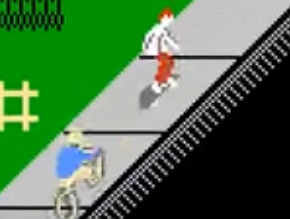

- The lonely wheel. She regularly crosses the screen. We don't know where it comes from, we don't know where it's going.
- Cars. You suspected it. There are few (one red, one green…). They are more present, and above all faster, in the original arcade version.
- Garden decorations and fences. Suburb obliged.
- Fire hydrants, manholes. Immobile, fortunately.
- Trees. Immobile, fortunately.
- Bins. Immob… Ok, stop.
- A remote-controlled car. Mobile, unfortunately. We don't know who is guiding her.
- A child on a tricycle. Maybe the one guiding the remote control car.
- A dog kennel. Nothing to say about it, but it is often accompanied by…
- …A dog, who pursues the delivery man.
- A big cat on the road. Really big.
- Lonely skateboarders. Normal, this is the period Back to the future.
Strangeness…cults
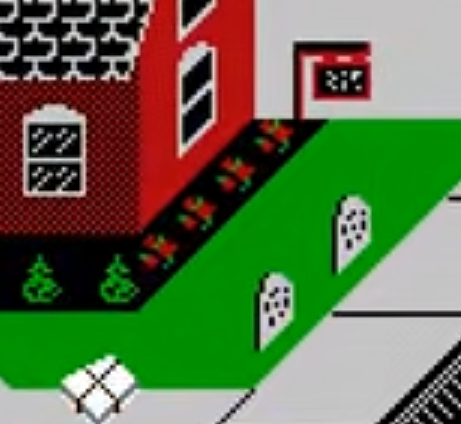

- THE breakdancer on the pavement. Quite an era, eh?
- I have already mentioned the three guys who welcome us on arrival of the tour bursting with joy at the bottom of a large empty stand. We didn't talk like that in 1988, but today we would find it “weird”.
- The jackhammer worker on the pavement. It doesn't pierce anything, of course, but it vibrates, and so do we.
- A lady who emerges from his house to pursue the delivery man with an unidentified object in his hand, perhaps a rolling pin.
- Burglars. They had escaped me: you can hit them with a newspaper throw, it earns points. But you can also miss them and explode a tile, of course.
- A tornado (small, certainly, but it's a tornado). And why not ?
- Graves in the garden. And they fall when you throw a newspaper at them (this is perhaps the most unusual detail of this game). Their presence is perhaps explained by another unusual appearance, that of…
- …The death in person. The grim Reaper, the Grim Reaper. Death, what.
- The most mysterious for me, and for many other people obviously: a guy in red who emerges from the garden, where he stood motionless, to cross the street. He wears some sort of large ring on his hand, or perhaps a rope. I thought he was the kind of cowboy who ties up calves in rodeos, but you can't make him out very well. In fact, it would be the reproduction of a very popular garden decoration at one time (see the last link at the end of the article): a statue of a jockey. Very, very strange.


That's it, in short Paperboy, it's a lot of humor and surrealism in a setting a priori banal and repetitive. Enough to have a good time despite its miserable score. About scores, the site Twingalaxes lists points records. On an Atari terminal, it's true (and in “easy street” mode, pfff), but it can give you an idea to calibrate yourself. Or rather so as not to standardize yourself.
Additional Resources
As experienced music lovers, you can't miss the game's shimmering soundtrack, here., on Niko's 8BitStereo YouTube channel, a major specialist in video game soundtracks.
The American advertisement for the NES version of the game on the YouTube channel RGTV (Retro games TV), here..
And there an excellent episode of Angry Video Game Nerd, fanatic from the Cinemassacre YouTube channel, who confirmed many things to me about this strange Paperboy NES version, notably on the difficulty of understanding the ramps and on the probable meaning of the strange Man in Red. Subtitled in French.





